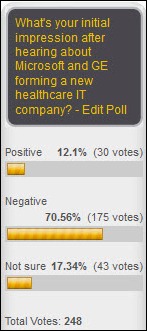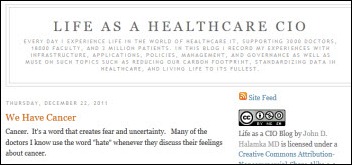The $50 billion Rural Health payout is welcome. In context, it's less than the total cost of the F22 raptor…
Monday Morning Update 12/26/11
From Hospital IT Guy: “Re: HIStalk. I don’t know how you produce such insightful and well-written news and comment as a part-time gig. Your posts give me a reality check and enhance my position as an HIT expert charged with leading us into a very uncertain future. Thanks for the body of work you produced this past year and for the work you hopefully will continue to produce in the year to come.” Thanks for those nice comments – they made my day. I have the luxury of being subsidized by hospital day job, which allows me to do whatever I want without pandering for a buck. New Year’s Day is a good time to take stock of where you are, so if you have ideas of how I could provide a better service to the industry (especially providers and patients), send them my way. I’m constrained by time (not to mention by being rather lazy and risk-averse) but I’m fairly creative in getting help and other resources when I need them. I don’t want to be sadly reflecting back from a nursing home bed, “I could have done so much more” and having only my bank account to produce as evidence that I wasn’t a total waste.
One of the first to-dos of the yet-unnamed HIT spawn of Microsoft and GE Healthcare should be to communicate to a skeptical market audience, with only 12% of poll respondents finding the announcement positive. New poll to your right, inspired by John Gomez’s article: if there’s a healthcare IT bubble, when will it burst?
My Time Capsule editorial from five years ago: 2006 Product Rankings – Pay Some Attention, But Not Too Much. It inadvertently highlights just how much Epic has changed the industry with its lengthening roster of top-ranked applications: “The most discouraging point is that no vendor does everything well, if you believe the scores. If you look at KLAS’s 15 main general solutions categories, you’d find 13 top-ranked vendors. If you’re a best-of-breed shop, you’ll end up with a lot of interfaced systems if you chase the winners. If you’re a single-vendor organization, some of your departments are going to be stuck with systems far short of being the best. And of course, in the next survey, they may all shuffle around anyway. ”
Weird News Andy wonders how much the patient was charged for the tape. Two ICU nurses at Utah Valley Regional Medical Center (UT) are fired for telling a moaning patient to shut up, then taping her mouth and laughing about it.
Listening: new from Phoenix-based Gooder, a cross between the infectious power pop of Gin Blossoms with hard-driving guitar and drums (Rush? Van Halen?) They have a really big, well-produced sound for a three-piece. The reader who recommended them has a relative in the band and didn’t really talk them up much (“I’m obliged to like them”) but I really like their sound.
Here’s the latest from Vince, who takes a break from profiling long-gone companies (and sadly, sometimes long-gone people who worked for them) and addresses how HIT vendors throw down at holiday party time. I like Slide 3, in which Vince, one of his company buds, and their wives are dressed to the nines in their hideous 1960s party fashions ready for a big night on the town. If you’re a 20-something industry noob, you will in 20 years or so look back with an equal mix of nostalgia and a little tinge of sadness when faced with images from your long-gone youth, which involved fewer wrinkles and pounds and visually obvious humble surroundings, yet beaming with both delight and surprise to have found a place in productive society and brimming with optimism about the endless future that lies ahead. You’ll know you’ve done well if looking back now is just as satisfying as looking ahead was then.
BIDMC CIO John Halamka announces on his blog that his wife Kathy has been diagnosed with breast cancer. He’s approaching it as you would expect for someone who’s both an engineer and a physician: he is reviewing her medical information, he has assembled a team of renowned experts, and he will be documenting the process with a weekly blog post. I had two immediate reactions: (a) I was surprised that I was affected by the news since I don’t know either John or his wife. I used to assume he was a self-promoting gasbag since he kept popping up everywhere, but the couple of times I’ve met him for a few seconds (as myself, not Mr. H) and interviewed him, he seemed to be a nice guy without much ego. Hearing about his wife was a bit of a blow. (b) as much as I’m happy that he has limitless resources available to him as a Harvard physician with a vast industry network, I kept thinking – what if it was my wife or mother? Why does his wife get better odds because of where he works and where they live?
That’s not a criticism of him at all, but rather an observation about how US healthcare works – it unfortunately helps to go to renowned facilities, to have enough time and money to demand the best when nobody’s offering it to you, and to challenge physicians for the best, personalized answers since healthcare is a cottage industry that is primitive if not indifferent with regard to standardized processes, best practices, and outcomes. Those of us who work in the system know that, while the majority of Americans get their care in undistinguished hospitals from undistinguished doctors whose treatment choices are often anything but evidence-based. I say that having worked in small-town hospitals that had the most incompetent physicians you could possibly imagine with a handful of pretty good ones thrown in, but all of them running thriving practices with patients who lived and died never knowing the difference. To this day, if I were to keel over in the waiting room of a small-town, for-profit hospital, the only medical instrument I want touching me is an ambulance gurney that’s taking me somewhere else in a hurry.
Update: John replied to me Christmas morning. I don’t know if I was clear in my brief writeup above, but he’s been very cool in my brief dealings with him, never too busy despite a superhuman scheduled to drop a few words of encouragement or deflect credit for some HIT development to someone else, which I think is the ultimate mark of a leader – he’s more than happy to let someone else have the limelight. He took the time (as did his wife Kathy) to respond to my comments above. Think about what must be going through their minds if you think this is trivial. There’s never a good time to receive sobering medical news, but imagine having it delivered just a few days before Christmas, with the expectation of being cheery around friends and family.
John writes:
At the same time I’m focused on Kathy’s care, I’m also deeply committed to quality, safety, efficiency, and equity in healthcare across the country. In the upcoming weeks, I’ll describe how the electronic records that coordinate Kathy’s treatment provide the same protocols to every BIDMC patient, regardless of insurance status, profession, or income. My goal is the "right care" – not too much nor too little – that follows best practices from evidence. Decision support driven "right care" is the only way we can hope to improve outcomes while bending the cost curve of healthcare spending that threatens the US economy. Universal healthcare supported by universal adoption of electronic and personal health records must be our guiding vision.
Kathy writes:
My life with John has been entwined for 32 years, so to say "we have cancer" cannot be more completely and utterly correct. True that physically, only one of use has the obvious organic symptoms, but our close partnership has been irrevocably changed by the diagnosis. Whatever lies ahead, it is impossible to go back to that innocent moment before hearing the word cancer.
I am luckier than most – I have health insurance, and access to a major urban medical center that is also a teaching and research hospital. But, in encouraging John to follow our progress publicly in his blog, I am keeping the memory of a friend close to my heart. She did not have health insurance (as a part time adjunct instructor of art). With this financial barrier, she unwittingly waited until the cancer had spread before seeking medical care, and although she fought bravely, she lost her battle with breast cancer.
Throughout my life, I have not needed medical care beyond occasional primary care visits and the birth of one child. My first weeks negotiating the barrage of new terminology, new tests, new doctors has been significantly eased by my access to a complete electronic medical record. Even more important to me, my doctors can work as a team with open access to all the same instant information to help me make the best decisions for my health. As I think about my lost friend, I also am thinking of all others with a breast cancer diagnosis, or other serious illnesses, and about how they manage to work toward their cure if they worry about health insurance, or have no access to an electronic medical record.
Health Information Partnership for Tennessee releases some well made HIE videos that anybody who needs to talk up the HIE concept can use. CEO Keith Cox sent over the link.
One more update about sponsor charity work. Iatric Systems can’t bring its dispersed workforce together for a company party, so it allows employees to payroll deduct charitable contributions that the company then percentage matches. More than $19,000 was donated this year to Save-a-Limb, Relay for Live Japan Earthquake, Alzheimer’s Association, and London Marathon (since they have UK employees.) |
The 21-year-old who posed as a surgeon while counseling patients in the public areas of two Oregon hospitals is sentenced three years in prison. He also claimed to be a Microsoft employee, porn producer, and credit counselor.
A point I’ve been pondering for years, fanned back to life by a reader’s comment. Hospitals enjoy quite modest (if not negative) revenue increases each year, almost wholly driven by what the federal government decides it’s willing to pay them. The country is insolvent and there’s no political will to fix that, so it’s a certainty that the government will be paying less. How, then, can hospitals afford to lock themselves into IT contracts, especially maintenance ones, whose percentage cost increase each year exceeds the revenue increase the hospital expects? That’s especially true of IT systems (most of them) that generate minimal return on investment. I guess that’s why someone had to invent the “IT is like plumbing” argument to justify buying technology without questioning return on investment, but I’m wondering how that rationalization will stand as the going gets tougher. IT departments have the same challenge – how do you justify a 10% IT budget increase when the organization is only expecting a 2% revenue increase, or why does IT keep growing when front-line employees are having their hours flexed or their jobs eliminated? The folks at the top who approve IT purchases and budgets often forget that there’s an ongoing cost to the systems they want to buy.
The pending absorption of Alamance Regional Medical Center (NC) by Cone Health raises IT questions: what will happen with Alamance’s Allscripts Sunrise system given that Cone and the other big systems nearby (Wake Forest Baptist, Novant) are on Epic? The respective CEOs say they’ll probably just try to connect the systems in some way since it’s too expensive to implement Epic at Alamance.
Both MEDITECH and Cerner announced that they will be returning as HIMSS conference exhibitors after an absence of several years. I asked both companies about that decision, with responses from Paul Berthiaume (public relations manager of MEDITECH) and Zane Burke (EVP of Cerner’s client organization.)
Cerner and MEDITECH stopped exhibiting at HIMSS at about the same time and announced their return at about the same time. Were the companies expecting competitors to follow their lead and are coming back now because they didn’t?
MEDITECH
MEDITECH’s decisions regarding HIMSS participation were and are influenced solely by our needs and the needs of our customers. We don’t concern ourselves with our competitors, and we’re not trying to set nor follow any "vendor trends." We’re doing what works for us. This year, we have a particularly compelling story to tell as a leading EHR vendor. We want to share our customers’ successes reaching Stages 6 and 7 as well as achieving Meaningful Use Attestation, and we want to congratulate another Baldrige Award winner. Best of all, we’re going to debut an exciting new Web-based ambulatory product.
Cerner
When we made the decision to not exhibit at HIMSS, we shifted to other strategies to engage with our clients and the marketplace. Since then, one consistent request across our client base was to have a presence at HIMSS for a more personal interaction with our executives, IT support staff, and other clients. Over the years, we continued our HIMSS engagement across the Interoperability Showcase, demos with our industry partners and by supporting the educational components of HIMSS. This year, we will participate in these activities again, and we are excited to be able to meet our clients’ request and have a presence on the exhibit floor.
What will the company’s exhibit hall presence be? Do you have enough HIMSS points for the big, prime location booth, or do you have to work your way back up?
MEDITECH
We’ll be unveiling a new 40×40 booth at HIMSS, which we are excited about, and we’ll have members of our physician team in the booth meeting with customers. We encourage everyone to visit us at Booth #774.
Cerner
We have confirmed a sizable amount of floor space. We’d be happy to share additional details closer to the event.
Both companies say their customers wanted the company to return to the exhibit hall. If that’s the case, was it a mistake to pull out in the first place? What influence did a tough, competitive market and the peaking of HITECH-related system decisions have?
MEDITECH
I believe you’re referring to an earlier interview I gave, where the emphasis of our return was placed on customer demand. The focus is truly more on the timing being right for us; it’s the right time for us to allocate these resources and dollars. Our customers did miss us, and we certainly paid attention to that. In particular, our return to HIMSS gives our customers an opportunity to see our new products and to meet our team of physicians.
Cerner
Cerner and our clients have made significant advancements over the last few years and we are looking forward to participating at HIMSS to showcase these advancements with our clients more broadly. Our decision to come back to the HIMSS tradeshow floor is driven by many factors, including what we all can acknowledge is a strong health care industry making huge strides to improve quality and reduce cost. The diverse HIMSS audience gives us a chance to reconnect with our current clients and showcase to the broader health care community some of the exciting advances we’ve made in recent years.
Merry Christmas, Happy Hanukkah, and a belated Happy Festivus to all. Thanks for everybody who reads, sponsors, or otherwise supports HIStalk. I hope your holidays are amazing and that 2012 is your best year ever.






Mr. H,
Your response to Hospital IT Guy is truly inspirational to all of us HIStalk addicts. However, I don’t think any of your readers buy into the comment that you are “rather lazy”.
With reference to your disdain for community hospitals and their doctors, you should read the hospital ratings posted by CMS and the Joint Commission. You wroite this in your discussion of John Halamka’s wifes unfortunate luck in getting breast cancer. You may be surprised to find that there are plenty of excellent community hospitals and physicians. People tend to get more personalized care in a community hospital by people who enjoy that atmosphere. All of the physicians were trained at the same big academic medical centers you admire, and many made a determined choice not to be caught up in that academic atmosphere but rather to care for patients more directly. Also, there are plenty of mediocre physcians at academic centers “of excellence.” We are all human beings with assets and liabilities and where we choose to practice has many facets.
ThaNks for sharing John And Kathy’s story. I’ve been in this amazing industry we call healthcare for nearly 30 years on provider And vendor side. It is a large, welcoming family of sorts. And we are all connected. John and Kathy, our prayers and support are with you.
Being relatively new to Healthcare IT, I too am perplexed by the perpetually increasing software maintenance contracts. In the Enterprise Software space, there are now third party companies that provide support for Enterprise Software companies at about a 50% discount. I can’t imagine these Enterprise Software companies (Oracle, SAP, Siebel, peopleSoft, etc) have software contracts very different from the HIT contracts, so why is this option missing in HIT maintenance?